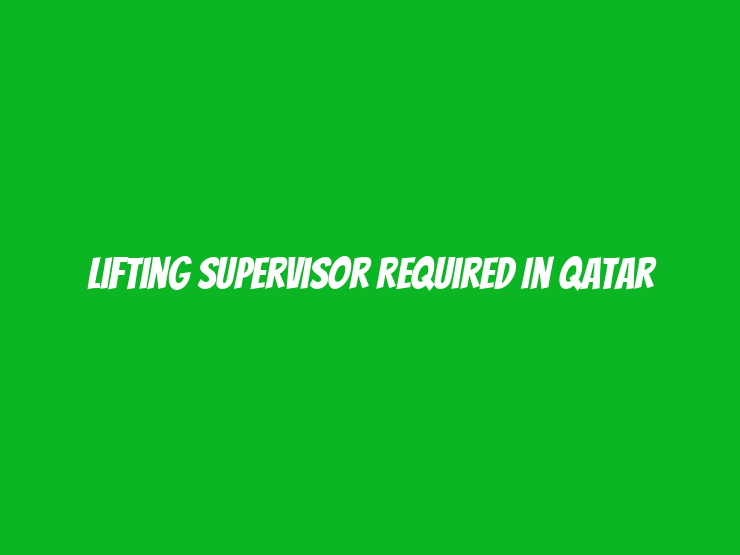A Lifting Supervisor is responsible for overseeing all lifting operations on a construction site or industrial setting, ensuring that all lifting activities are conducted safely and in compliance with regulations. This role involves planning, coordinating, and supervising the use of cranes, hoists, and other lifting equipment to move heavy materials or equipment. The Lifting Supervisor works closely with crane operators, riggers, and other personnel to ensure smooth operations while adhering to safety standards and protocols. This position requires strong knowledge of lifting equipment, risk assessment skills, and a commitment to ensuring safe work practices.
| Salary | Market Competitive |
| Experience | 3 – 5 years |
| Location | Qatar |
| Qualification | Degree or Diploma |
| Posted | 04 October 2024 |
| Job Type | Full-Time |
| Posted by | Habeebi Recruiter |
| last date to apply | apply within 15 days of posting |
Key Responsibilities
1. Planning and Coordinating Lifting Operations
The Lifting Supervisor is responsible for planning all lifting operations, including preparing lift plans and assessing the site for potential risks. They ensure that all equipment and personnel are properly prepared for each lifting task. This involves coordinating with crane operators, riggers, and other workers to ensure that lifting activities are carried out efficiently and safely. They are also responsible for selecting the right lifting equipment based on the load and conditions.
2. Supervising Lifting Teams
A critical part of the Lifting Supervisor’s role is overseeing the lifting teams on-site. This includes crane operators, riggers, and signalers. The supervisor ensures that all team members are aware of their responsibilities and that they follow safety guidelines at all times. By monitoring their activities and providing guidance, the Lifting Supervisor helps maintain a safe and organized work environment during lifting operations.
3. Ensuring Compliance with Safety Regulations
Safety is a top priority in lifting operations. The Lifting Supervisor is responsible for ensuring that all lifting activities comply with local regulations, industry standards, and company policies. They conduct safety briefings before lifting begins, review safety procedures with the team, and ensure that personal protective equipment (PPE) is worn. The Lifting Supervisor also makes sure that all equipment is properly maintained and inspected before use to avoid accidents.
4. Risk Assessment and Hazard Identification
Before any lifting operation, the Lifting Supervisor conducts a thorough risk assessment to identify potential hazards, such as unstable ground, overhead obstacles, or weather conditions. They evaluate the lifting site to ensure that it is free from hazards and take necessary precautions to mitigate risks. This process helps in avoiding accidents and ensuring that all lifting activities are performed under safe conditions.
5. Communication and Coordination
Effective communication is crucial during lifting operations. The Lifting Supervisor ensures that all team members, including crane operators and signalers, are in constant communication during the lift. They use hand signals, radios, or other communication devices to relay instructions and ensure that the lifting process runs smoothly. Clear communication helps prevent misunderstandings or errors that could lead to accidents.
6. Lifting Equipment Inspection and Maintenance
The Lifting Supervisor is responsible for ensuring that all lifting equipment, including cranes, hoists, slings, and shackles, is in good working condition. They inspect equipment regularly to ensure it meets safety standards and is free from defects. If any issues are identified, the supervisor coordinates with maintenance teams to perform necessary repairs or replacements before resuming operations.
7. Training and Development
The Lifting Supervisor plays a key role in training and mentoring lifting teams. They provide guidance on safe lifting practices, proper use of equipment, and industry regulations. Through regular training sessions and on-the-job coaching, they help team members improve their skills and stay up-to-date with the latest safety standards and best practices.
8. Incident Reporting and Investigation
In the event of an accident or near-miss, the Lifting Supervisor is responsible for documenting the incident and conducting an investigation to determine the cause. They work with safety officers and management to analyze the situation and implement corrective measures to prevent future incidents. This helps in maintaining a culture of safety and continuous improvement on the job site.
9. Continuous Improvement and Best Practices
The Lifting Supervisor constantly looks for ways to improve the efficiency and safety of lifting operations. They stay informed about the latest industry trends, technological advancements, and best practices in lifting techniques. By implementing new methods and technologies, the supervisor ensures that lifting operations are carried out with the highest level of safety and efficiency.
How to apply:
Send your updated resume to our email or directly reach us at our phone:
Email: gccdohaqatar@gmail.com
Telephone: +70580603

